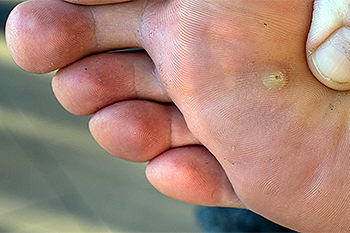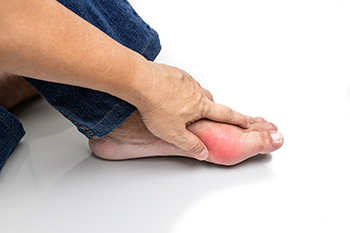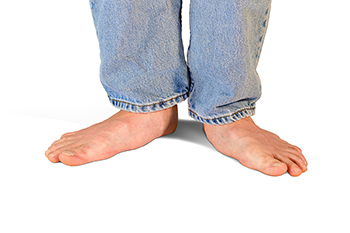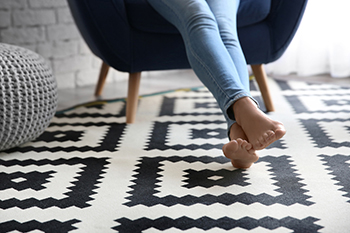Copyright © Michigan Foot and Ankle | Site Map | Nondiscrimination Policy | Design by: Podiatry Content Connection
September 2023
Recognizing the Telltale Symptoms of Plantar Warts

Plantar warts are a common, but often misunderstood, skin condition that can be both uncomfortable and unsightly. These warts are caused by the human papillomavirus, abbreviated HPV, and specifically thrive on the soles of the feet, making them a unique challenge to deal with. Recognizing the symptoms is crucial for early detection and effective treatment. One of the hallmark signs of plantar warts is the appearance of small, grainy growths on the bottom of the foot. These warts may have tiny black dots, known as wart seeds within them, which are actually clotted blood vessels. Plantar warts can cause pain or discomfort, especially when pressure is applied, such as when walking or standing. These warts often have a tough, thickened layer of skin over them, making them appear flat against the foot's surface. They may also present with an irregular border and vary in color from flesh toned to brown or gray. It is essential to remember that plantar warts can sometimes be mistaken for other foot conditions, so if you suspect you have one, it is suggested that you consult a podiatrist for a proper diagnosis and appropriate treatment options.
Plantar warts can be very uncomfortable. If you need your feet checked, contact one of our podiatrists from Michigan Foot and Ankle. Our doctors will assist you with all of your foot and ankle needs.
About Plantar Warts
Plantar warts are the result of HPV, or human papillomavirus, getting into open wounds on the feet. They are mostly found on the heels or balls of the feet.
While plantar warts are generally harmless, those experiencing excessive pain or those suffering from diabetes or a compromised immune system require immediate medical care. Plantar warts are easily diagnosed, usually through scraping off a bit of rough skin or by getting a biopsy.
Symptoms
- Lesions on the bottom of your feet, usually rough and grainy
- Hard or thick callused spots
- Wart seeds, which are small clotted blood vessels that look like little black spots
- Pain, discomfort, or tenderness of your feet when walking or standing
Treatment
- Freezing
- Electric tool removal
- Laser Treatment
- Topical Creams (prescription only)
- Over-the-counter medications
To help prevent developing plantar warts, avoid walking barefoot over abrasive surfaces that can cause cuts or wounds for HPV to get into. Avoiding direct contact with other warts, as well as not picking or rubbing existing warts, can help prevent the further spread of plantar warts. However, if you think you have developed plantar warts, speak to your podiatrist. He or she can diagnose the warts on your feet and recommend the appropriate treatment options.
If you have any questions please feel free to contact one of our offices located in Ferndale, and Milford, MI . We offer the newest diagnostic and treatment technologies for all your foot and ankle needs.
Understanding What Causes Gout

Gout is a type of arthritis that is caused by the accumulation of uric acid crystals in the joints. This condition primarily affects the joints, with the big toe being a common target. The development of gout is closely linked to high levels of uric acid in the blood, a condition known as hyperuricemia. Uric acid is a byproduct of the breakdown of purines found in many foods and beverages. When the body produces too much uric acid or fails to excrete it efficiently, uric acid crystals can form and settle in the joints, leading to inflammation, swelling, and intense pain. Several factors can contribute to the risk of developing gout, including genetics, diet, and lifestyle choices. Additionally, consuming purine-rich foods, excessive alcohol consumption, and certain medical conditions can all elevate uric acid levels and increase the likelihood of gout attacks. Understanding the causes of gout is crucial for managing and preventing gout flare-ups, allowing individuals to enjoy a better quality of life. If you have had one or more gout attacks, it is strongly suggested that you confer with a podiatrist who can help you manage this condition.
Gout is a painful condition that can be treated. If you are seeking treatment, contact one of our podiatrists from Michigan Foot and Ankle. Our doctors will treat your foot and ankle needs.
What Is Gout?
Gout is a form of arthritis that is characterized by sudden, severe attacks of pain, redness, and tenderness in the joints. The condition usually affects the joint at the base of the big toe. A gout attack can occur at any random time, such as the middle of the night while you are asleep.
Symptoms
- Intense Joint Pain - Usually around the large joint of your big toe, and it most severe within the first four to twelve hours
- Lingering Discomfort - Joint discomfort may last from a few days to a few weeks
- Inflammation and Redness -Affected joints may become swollen, tender, warm and red
- Limited Range of Motion - May experience a decrease in joint mobility
Risk Factors
- Genetics - If family members have gout, you’re more likely to have it
- Medications - Diuretic medications can raise uric acid levels
- Gender/Age - Gout is more common in men until the age of 60. It is believed that estrogen protects women until that point
- Diet - Eating red meat and shellfish increases your risk
- Alcohol - Having more than two alcoholic drinks per day increases your risk
- Obesity - Obese people are at a higher risk for gout
Prior to visiting your podiatrist to receive treatment for gout, there are a few things you should do beforehand. If you have gout you should write down your symptoms--including when they started and how often you experience them, important medical information you may have, and any questions you may have. Writing down these three things will help your podiatrist in assessing your specific situation so that he or she may provide the best route of treatment for you.
If you have any questions, please feel free to contact one of our offices located in Ferndale, and Milford, MI . We offer the newest diagnostic and treatment technologies for all your foot care needs.
Treatment Options for Flat Feet

Flat feet is a condition where the arch of the foot is either too low or nonexistent. As a rule, flat feet are rarely considered to be medically serious. However, flat feet can sometimes lead to discomfort or complications, and some type of treatment may be necessary. If you are experiencing pain around the ankle or aching in the arch of the foot, it may be time to consider treatment. Additionally, if you notice that your shoes are wearing out quickly, it could be a sign that your flat feet are causing undue stress on your footwear. Non-surgical treatment includes changing footwear, investing in orthotic inserts for improved arch support, and performing certain exercises to improve the strength and flexibility of the foot muscles. These can potentially reduce pain and discomfort. Prescription painkillers may be recommended to manage pain and any stiffness associated with flat feet. When other treatments have failed or if there's a structural issue with the bones, tissues, or muscles in the feet, surgery may be considered as a last resort. For guidance about treatment options for flat feet, it is suggested that you consult a podiatrist.
Flatfoot is a condition many people suffer from. If you have flat feet, contact one of our podiatrists from Michigan Foot and Ankle. Our doctors will treat your foot and ankle needs.
What Are Flat Feet?
Flatfoot is a condition in which the arch of the foot is depressed and the sole of the foot is almost completely in contact with the ground. About 20-30% of the population generally has flat feet because their arches never formed during growth.
Conditions & Problems:
Having flat feet makes it difficult to run or walk because of the stress placed on the ankles.
Alignment – The general alignment of your legs can be disrupted, because the ankles move inward which can cause major discomfort.
Knees – If you have complications with your knees, flat feet can be a contributor to arthritis in that area.
Symptoms
- Pain around the heel or arch area
- Trouble standing on the tip toe
- Swelling around the inside of the ankle
- Flat look to one or both feet
- Having your shoes feel uneven when worn
Treatment
If you are experiencing pain and stress on the foot you may weaken the posterior tibial tendon, which runs around the inside of the ankle.
If you have any questions please feel free to contact one of our offices located in Ferndale, and Milford, MI . We offer the newest diagnostic and treatment technologies for all your foot and ankle needs.
Gout Pain Can Be Managed
Symptoms of Charcot-Marie-Tooth Disease

Charcot-Marie-Tooth disease is a cluster of inherited genetic disorders that impact the peripheral nervous system. These neuropathies disrupt the intricate network responsible for movement and sensation within the extremities, including the feet. The peripheral nervous system serves as a communication bridge between the brain, spinal cord, and muscles. Charcot-Marie-Tooth disease results in a range of symptoms that interfere with this process and dramatically influence foot health. Gradual muscle wasting in the feet and legs is a hallmark of this disease, causing increasing weakness and reduced control over time. This frequently leads to difficulties in mobility and balance. It also can result in high foot arches, known as pes cavus, and clawed toes. These structural changes can further impede proper foot function and comfort. An altered gait, often high-stepping, and a slapping sound when walking are only some of the common symptoms. Poor balance and a risk of falling are others, caused by weakened muscles and loss of sensation. Although there is no cure, it is possible to manage foot-related challenges and potentially slow down the progression of the disease. For guidance, it is suggested that you make an appointment with a podiatrist.
When dealing with systemic disease of the feet, it is extremely important to check the affected areas routinely so that any additional problems are caught quickly. If you have any concerns about your feet and ankles contact one of our podiatrists from Michigan Foot and Ankle. Our doctors will assist you with all of your podiatric needs.
Systemic Diseases of the Feet
Systemic diseases affect the whole body, and symptoms usually are displayed in the feet. This condition can make a patient’s ability to walk unbearable. Systemic diseases include gout, diabetes mellitus, neurological disorders, and arthritis.
Gout – is caused by an excess of uric acid in the body. Common symptoms include pain, inflammation, and redness at the metatarsal/phalangeal joint of the base big toe. Gout can be treated by NSAIDs to relieve pain and inflammation, and other drugs that lower the acid levels in the body.
Diabetes mellitus – is an increase in the level of blood sugar that the body cannot counteract with its own insulin. Failure to produce enough insulin is a factor in Diabetes.
Diabetes of the Feet
Diabetic Neuropathy – may lead to damaged nerves and affect the feet through numbness and loss of sensation.
Peripheral Vascular Disease – can restrict the blood flow to the feet, and often times lead to amputation of the feet.
If you have any questions please feel free to contact one of our offices located in Ferndale, and Milford, MI . We offer the newest diagnostic and treatment technologies for all your foot and ankle needs.







